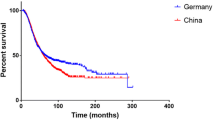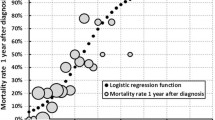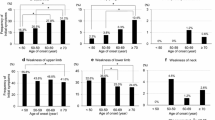Abstract
The etiology of amyotrophic lateral sclerosis (ALS) remains unknown, but existing data argue for a role of creatinine in ALS pathophysiology. Our aim is to clarify the correlation between serum creatinine and ALS in Chinese population. A total of 512 sporadic ALS (SALS) patients and 501 age- and gender-matched healthy controls were included. Revised ALS Functional Rating Scale (ALS-FRS-R) was used to assess the motor functional status of SALS patients. Survival analysis was performed using Kaplan–Meier method. Serum creatinine levels were significantly lower in SALS patients than in controls (p < 0.001). Patients with the second, the third and highest quartiles of creatinine levels had a significantly lower presence of ALS compared to those with the lowest quartile (p for trend <0.001). However, decreased presence of ALS was not found in the highest quartiles compared with the lowest quartiles in females. Sporadic ALS patients with different site of onset have similar serum creatinine levels, but underweight patients presented lower levels of serum creatinine. Patients with low serum creatinine levels are more likely to have severe motor impairment and low body mass index (BMI) values. This study demonstrates that SALS patients have lower serum creatinine levels than well-matched controls. Higher levels of serum creatinine are less likely to be associated with the presence of ALS in Chinese populations. Low serum creatinine levels may be related to severe motor impairment in SALS patients, after adjusting the confounding factor—BMI. However, serum creatinine has no deleterious impact on survival in ALS.
Similar content being viewed by others
References
Turner MR, Hardiman O, Benatar M, Brooks BR, Chio A, de Carvalho M, Ince PG, Lin C, Miller RG, Mitsumoto H, Nicholson G, Ravits J, Shaw PJ, Swash M, Talbot K, Traynor BJ, Van den Berg LH, Veldink JH, Vucic S, Kiernan MC (2013) Controversies and priorities in amyotrophic lateral sclerosis. Lancet Neurol 12(3):310–322. doi:10.1016/S1474-4422(13)70036-X
Kiernan MC, Vucic S, Cheah BC, Turner MR, Eisen A, Hardiman O, Burrell JR, Zoing MC (2011) Amyotrophic lateral sclerosis. Lancet 377(9769):942–955. doi:10.1016/S0140-6736(10)61156-7
Kataoka H, Kiriyama T, Kobayashi Y, Horikawa H, Ueno S (2013) Clinical outcomes and serum uric acid levels in elderly patients with amyotrophic lateral sclerosis aged >/=70 years. Am J Neurodegener Dis 2(2):140–144
Aksoy D, Cevik B, Solmaz V, Kurt SG (2013) Clinical, demographic and prognostic features of sporadic amyotrophic lateral sclerosis in Northern Turkey. Int J Neurosci. doi:10.3109/00207454.2013.823605
Factor-Litvak P, Al-Chalabi A, Ascherio A, Bradley W, Chio A, Garruto R, Hardiman O, Kamel F, Kasarskis E, McKee A, Nakano I, Nelson LM, Eisen A (2013) Current pathways for epidemiological research in amyotrophic lateral sclerosis. Amyotroph Lateral Scler Frontotemporal Degener 14(Suppl 1):33–43. doi:10.3109/21678421.2013.778565
Korner S, Kollewe K, Ilsemann J, Muller-Heine A, Dengler R, Krampfl K, Petri S (2013) Prevalence and prognostic impact of comorbidities in amyotrophic lateral sclerosis. Eur J Neurol 20(4):647–654. doi:10.1111/ene.12015
Chio A, Logroscino G, Hardiman O, Swingler R, Mitchell D, Beghi E, Traynor BG (2009) Prognostic factors in ALS: a critical review. Amyotroph Lateral Scler 10(5–6):310–323. doi:10.3109/17482960802566824
Lawton KA, Cudkowicz ME, Brown MV, Alexander D, Caffrey R, Wulff JE, Bowser R, Lawson R, Jaffa M, Milburn MV, Ryals JA, Berry JD (2012) Biochemical alterations associated with ALS. Amyotroph Lateral Scler 13(1):110–118. doi:10.3109/17482968.2011.619197
Paillisse C, Lacomblez L, Dib M, Bensimon G, Garcia-Acosta S, Meininger V (2005) Prognostic factors for survival in amyotrophic lateral sclerosis patients treated with riluzole. Amyotroph Lateral Scler Other Motor Neuron Disord 6(1):37–44. doi:10.1080/14660820510027035 (V21L0T6048V2555N)
Ikeda K, Hirayama T, Takazawa T, Kawabe K, Iwasaki Y (2012) Relationships between disease progression and serum levels of lipid, urate, creatinine and ferritin in Japanese patients with amyotrophic lateral sclerosis: a cross-sectional study. Intern Med 51(12):1501–1508 (DN/JST.JSTAGE/internalmedicine/51.7465)
Ikeda K, Kawabe K, Iwasaki Y (2009) Do serum uric acid levels reflect oxidative stress in the progression of ALS? J Neurol Sci 287(1–2):294. doi:10.1016/j.jns.2009.08.008 (S0022-510X(09)00764-310) (author reply 295)
Zoccolella S, Simone IL, Capozzo R, Tortelli R, Leo A, D’Errico E, Logroscino G (2011) An exploratory study of serum urate levels in patients with amyotrophic lateral sclerosis. J Neurol 258(2):238–243. doi:10.1007/s00415-010-5735-9
Skali H, Uno H, Levey AS, Inker LA, Pfeffer MA, Solomon SD (2011) Prognostic assessment of estimated glomerular filtration rate by the new Chronic Kidney Disease Epidemiology Collaboration equation in comparison with the Modification of Diet in Renal Disease study equation. Am Heart J 162(3):548–554. doi:10.1016/j.ahj.2011.06.006
Wyss M, Kaddurah-Daouk R (2000) Creatine and creatinine metabolism. Physiol Rev 80(3):1107–1213
Viollet L, Gailey S, Thornton DJ, Friedman NR, Flanigan KM, Mahan JD, Mendell JR (2009) Utility of cystatin C to monitor renal function in Duchenne muscular dystrophy. Muscle Nerve 40(3):438–442. doi:10.1002/mus.21420
Simons JP, Schols AM, Buurman WA, Wouters EF (1999) Weight loss and low body cell mass in males with lung cancer: relationship with systemic inflammation, acute-phase response, resting energy expenditure, and catabolic and anabolic hormones. Clin Sci (Lond) 97(2):215–223
Hashizume A, Katsuno M, Banno H, Suzuki K, Suga N, Mano T, Atsuta N, Oe H, Watanabe H, Tanaka F, Sobue G (2012) Longitudinal changes of outcome measures in spinal and bulbar muscular atrophy. Brain 135(Pt 9):2838–2848. doi:10.1093/brain/aws170
Baxmann AC, Ahmed MS, Marques NC, Menon VB, Pereira AB, Kirsztajn GM, Heilberg IP (2008) Influence of muscle mass and physical activity on serum and urinary creatinine and serum cystatin C. Clin J Am Soc Nephrol 3(2):348–354. doi:10.2215/CJN.02870707
Ascherio A, Weisskopf MG, O’Reilly EJ, McCullough ML, Calle EE, Rodriguez C, Thun MJ (2004) Coffee consumption, gender, and Parkinson’s disease mortality in the cancer prevention study II cohort: the modifying effects of estrogen. Am J Epidemiol 160(10):977–984. doi:10.1093/aje/kwh312
Nilsen J, Brinton RD (2004) Mitochondria as therapeutic targets of estrogen action in the central nervous system. Curr Drug Targets CNS Neurol Disord 3(4):297–313
Cocker J, Mason HJ, Warren ND, Cotton RJ (2011) Creatinine adjustment of biological monitoring results. Occup Med (Lond) 61(5):349–353. doi:10.1093/occmed/kqr084
Traxinger K, Kelly C, Johnson BA, Lyles RH, Glass JD (2013) Prognosis and epidemiology of amyotrophic lateral sclerosis: analysis of a clinic population, 1997–2011. Neurol Clin Pract 3(4):313–320. doi:10.1212/CPJ.0b013e3182a1b8ab.CPJ200147
Reich-Slotky R, Andrews J, Cheng B, Buchsbaum R, Levy D, Kaufmann P, Thompson JL (2013) Body mass index (BMI) as predictor of ALSFRS-R score decline in ALS patients. Amyotroph Lateral Scler Frontotemporal Degener 14(3):212–216. doi:10.3109/21678421.2013.770028
Paganoni S, Deng J, Jaffa M, Cudkowicz ME, Wills AM (2011) Body mass index, not dys lipidemia, is an independent predictor of survival in amyotrophic lateral sclerosis. Muscle Nerve 44(1):20–24. doi:10.1002/mus.22114
Shimizu T, Nagaoka U, Nakayama Y, Kawata A, Kugimoto C, Kuroiwa Y, Kawai M, Shimohata T, Nishizawa M, Mihara B, Arahata H, Fujii N, Namba R, Ito H, Imai T, Nobukuni K, Kondo K, Ogino M, Nakajima T, Komori T (2012) Reduction rate of body mass index predicts prognosis for survival in amyotrophic lateral sclerosis: a multicenter study in Japan. Amyotroph Lateral Scler 13(4):363–366. doi:10.3109/17482968.2012.678366
Marin B, Desport JC, Kajeu P, Jesus P, Nicolaud B, Nicol M, Preux PM, Couratier P (2011) Alteration of nutritional status at diagnosis is a prognostic factor for survival of amyotrophic lateral sclerosis patients. J Neurol Neurosurg Psychiatry 82(6):628–634. doi:10.1136/jnnp.2010.211474
Slowie LA, Paige MS, Antel JP (1983) Nutritional considerations in the management of patients with amyotrophic lateral sclerosis (ALS). J Am Diet Assoc 83(1):44–47
Klivenyi P, Ferrante RJ, Matthews RT, Bogdanov MB, Klein AM, Andreassen OA, Mueller G, Wermer M, Kaddurah-Daouk R, Beal MF (1999) Neuroprotective effects of creatine in a transgenic animal model of amyotrophic lateral sclerosis. Nat Med 5(3):347–350. doi:10.1038/6568
Shefner JM, Cudkowicz ME, Schoenfeld D, Conrad T, Taft J, Chilton M, Urbinelli L, Qureshi M, Zhang H, Pestronk A, Caress J, Donofrio P, Sorenson E, Bradley W, Lomen-Hoerth C, Pioro E, Rezania K, Ross M, Pascuzzi R, Heiman-Patterson T, Tandan R, Mitsumoto H, Rothstein J, Smith-Palmer T, MacDonald D, Burke D (2004) A clinical trial of creatine in ALS. Neurology 63(9):1656–1661 (63/9/1656)
Groeneveld GJ, Veldink JH, van der Tweel I, Kalmijn S, Beijer C, de Visser M, Wokke JH, Franssen H, van den Berg LH (2003) A randomized sequential trial of creatine in amyotrophic lateral sclerosis. Ann Neurol 53(4):437–445. doi:10.1002/ana.10554
Atassi N, Ratai EM, Greenblatt DJ, Pulley D, Zhao Y, Bombardier J, Wallace S, Eckenrode J, Cudkowicz M, Dibernardo A (2010) A phase I, pharmacokinetic, dosage escalation study of creatine monohydrate in subjects with amyotrophic lateral sclerosis. Amyotroph Lateral Scler 11(6):508–513. doi:10.3109/17482961003797130
Su XW, Simmons Z, Mitchell RM, Kong L, Stephens HE, Connor JR (2013) Biomarker-based predictive models for prognosis in amyotrophic lateral sclerosis. JAMA Neurol. doi:10.1001/jamaneurol.2013.4646
Acknowledgments
We thank the patients and their families for their participation in this project. This study was supported by National Natural Science Foundation of China (Grant No. 81301093).
Author information
Authors and Affiliations
Corresponding author
Rights and permissions
About this article
Cite this article
Chen, X., Guo, X., Huang, R. et al. An exploratory study of serum creatinine levels in patients with amyotrophic lateral sclerosis. Neurol Sci 35, 1591–1597 (2014). https://doi.org/10.1007/s10072-014-1807-4
Received:
Accepted:
Published:
Issue Date:
DOI: https://doi.org/10.1007/s10072-014-1807-4




